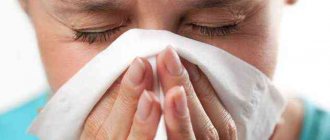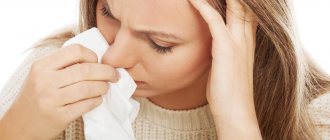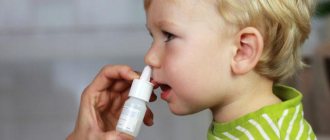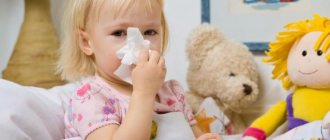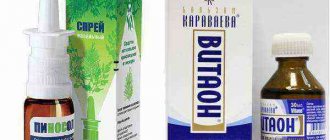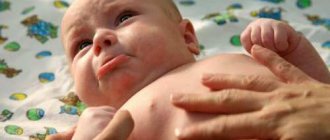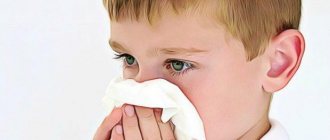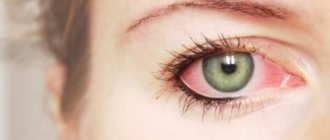Many believe that allergic rhinitis in a child is a seasonal phenomenon, associated exclusively with the flowering of birch or poplar, and goes away on its own. In fact, hay fever (that is the name of this disease) does not just bring discomfort. Because of it, the child’s health worsens, and if the disease is not treated, the child’s allergic rhinitis can become chronic. And this, in turn, can lead to the development of severe forms of rhinitis and even bronchial asthma, not to mention dermatitis and other phenomena accompanying hay fever.
What causes allergies
As a rule, when discussing the treatment of allergic rhinitis in children, one of the first measures is eliminating the allergen. You need to understand which plant causes the allergy. There are several thousand plant species, but only about 60 species produce pollen that can cause allergic reactions.
In our latitudes, these are almost all wind-pollinated grasses and trees. When alder, birch and maple begin to bloom in April or May, and a little later - ash and oak, allergic rhinitis occurs. At the beginning of summer, poplar and coniferous trees (spruce and pine) bloom, and you can also be allergic to them. Dandelions are also not at all harmless. In summer, linden and many meadow grasses bloom, the pollen of which
contributes to the manifestation of hay fever. And towards the end of summer, residents of the southern regions are faced with such a problem as an allergic reaction to various weeds, in particular to ragweed.
In order to identify which of these plants caused the allergy, various testing methods are used. But for children under 3 years of age they are not very informative, so parents often have to determine a potential allergen experimentally.
However, it will not be enough to eliminate only the main provocateur. There is such a thing as cross allergy. It means that an undesirable reaction occurs not only to pollen, but also to products or preparations based on plants, the molecules of which have the same areas with the allergen molecules.
For example, if a child has an allergic reaction to birch blossoms, then he will also react to hazel (not only nuts, but also leaves and pollen), apples, peaches, cherries, celery, carrots and potatoes. From herbal remedies it will be necessary to exclude not only those that contain birch leaves and buds, but also those that contain alder cones.
If a child is allergic to wormwood, then a similar reaction will be caused by almost all citrus fruits (tangerines are the least likely to cause it, most often oranges), sunflower seeds in any form, including halva, as well as chicory and honey. Among the herbs that can be dangerous in such cases are wormwood, calendula, string and chamomile, regardless of the form of use.
It happens that quinoa causes allergies. Then the baby should not be given spinach and beets. But cereals, although their flowering leads to hay fever, are actually relatively safe.
Symptoms of a runny nose in a child
intestinal infections are a kind of harbinger
infantsintoxication of the skin.
Manifestations of a runny nose in children are:
- feeling of nasal congestion;
- rhinorrhea;
- sneezing;
- lacrimation.
comes out with forms of rhinitis (
runny nose
) are:
- acute rhinitis;
- chronic rhinitis;
- atrophic rhinitis;
- vasomotor rhinitis.
Acute rhinitis with the development of adenoiditis
premature babies
Chronic rhinitis Atrophic rhinitis Vasomotor rhinitis
Fever and runny nose in a child
Temperature options depending on the etiology of the runny nose
| Type of infection | Main symptoms | Temperature characteristic |
| Runny nose due to rhinovirus infection | Profuse runny nose, accompanied by sneezing and congestion. The mucous discharge from the nose is always copious. | The temperature varies within normal limits, sometimes reaching 37.5 degrees. |
| Runny nose due to adenovirus infection | Runny nose with moderate mucous discharge and nasal congestion. | The temperature varies from 38 to 39 degrees. |
| Runny nose due to rotavirus infection | A runny nose and other respiratory symptoms are combined with manifestations of gastroenteritis - vomiting, diarrhea. | The temperature rose sharply to 39 degrees. |
| Runny nose due to respiratory syncytial infection | Runny nose, quickly complicated by the development of bronchiolitis and pneumonia. | There is a moderate low-grade fever (37 – 37.2 degrees ), rarely the temperature rises to 38 degrees. |
Complications of a runny nose in children
runny nose , deviated nasal septum The consequences of a runny nose in children are:
- rapid fatigue;
- sleep disturbance;
- memory loss;
- development of chronic rhinitis and sinusitis;
- stop in the physical development of the child;
- deformation of the facial skeleton and chest bones;
- disruption of metabolic processes;
- disruption of the respiratory and cardiovascular systems;
- development of allergic reactions.
Signs of allergic rhinitis in a child
Although it is believed that babies do not suffer from allergies, in fact the disease has become much younger today. Symptoms of allergic rhinitis in children do not even appear at the age of 5, but much earlier. Young mothers often think that it is a cold and continue to treat their child for ARVI, which only worsens the situation.
It is important to know what causes hay fever. Plays a big role
hereditary factor. If both parents of a baby suffer from allergies, then the probability of developing the same disease is 70%. But we must remember that it is not the disease itself that is transmitted, but the predisposition to such reactions. That is, parents may be allergic to completely different substances. In any case, only a doctor can determine the presence of the disease.
When should you contact a specialist? Very often, hay fever actually develops after an acute respiratory viral infection, when the child’s immunity is weakened, the protective barriers of the mucous membranes have not yet been restored, and the upper respiratory tract is vulnerable. If this coincides with the flowering season, you may not even notice how one disease turns into another. It happens that the effects of several factors are intertwined: stress, taking certain medications, heredity.
To understand what you are dealing with, you need to know the symptoms and treatment of hay fever. Although it is very similar to SARS, there are a number of differences. First you need to pay attention to the child’s snot. For example, a sign of a bacterial infection is a change in their color.
With a viral infection, they remain liquid and transparent only for the first couple of days, and then they become thick and cloudy, and after about a week they stop. With allergic rhinitis, the phenomenon is protracted. At the same time, for a week or more, the snot remains transparent, liquid and flows from both nostrils (and in case of a bacterial infection, only from one).
Symptoms of Allergic rhinitis
Seasonal allergic rhinitis in infants manifests itself actively during the flowering of various plants, as there is active constant contact with the irritant. The child’s mucous membrane will react actively: in addition to nasal congestion, redness of the white of the eye, ears, and nostrils may occur. In addition, the child begins to actively sneeze, itch, and swell (the face). Moms need to be careful! Children of this age often experience the disease virtually asymptomatically. The only thing that can indicate an allergy is a slight redness of the nose, which disappears after the flowering period on its own (any sign is a reason to go to the doctor).
Persistent allergic-type rhinitis manifests itself in the form of a stuffy nose all the time. In the morning, the newborn has constant bouts of sneezing, and by night the swelling intensifies and the nose becomes more stuffy, which significantly interferes with the child’s ability to sleep. When it's cold outside, it leads to increased tearing. This type of allergy can be divided into degrees of severity: severe, moderate and mild.
Basic diagnostic methods
Initially, when a runny nose appears, parents should take their child to the pediatrician to make sure that it is not a cold, but an allergy. After this, the baby should be examined by an otolaryngologist. The ENT doctor must also confirm that this is not ARVI, sinusitis or other diseases, and in addition, he examines the passages of the child’s nose to exclude foreign bodies.
If the likelihood of another disease has disappeared, diagnosis begins with an allergist. To find out how to treat allergic rhinitis , the doctor must determine the severity of the disease, as well as find out what exactly caused the disorder. To do this, 2 main analyzes are carried out:
- a smear for the number of eosinophils (in a child suffering from allergies, this figure is above 5% of the total number of cells);
- blood test to determine the level of immunoglobulin (ill health is indicated by an increased level of immunoglobulin E, above 100 IU).
The allergen is also determined by a blood test. If you do not study all the causes of the disease, then further treatment will be completely unproductive. During treatment, parents should isolate the child from the irritant.
Treatment of allergic rhinitis in children can only be done after all tests have been carried out, otherwise it may not bear fruit.
What else to pay attention to
Any infectious disease is accompanied by at least a slight increase in temperature, and with the virus there is also aching in the joints. With hay fever there are no these symptoms. But headaches and dizziness do happen. In particular, this may be caused by mild swelling.
A characteristic symptom of allergic rhinitis is considered to be frequent sneezing, to which is added itching in the most “problem” areas: on the bend of the elbow, under the knee, sometimes right on the face, but this is a rather rare occurrence. Swelling of the mucous membranes is often accompanied by conjunctivitis and even blepharitis. The latter arises from cross allergens.
Causes of allergic rhinitis in children
The risk group includes children who have a relative in the family with a tendency to allergic diseases. The root cause of rhinitis lies in the body’s heightened sensitivity to certain allergens, for example these may be:
- household or industrial dust;
- Pets;
- Food;
- medicines;
- plant pollen;
- various fungi.
Considering the intense signs of allergies and rhinitis, there are 3 degrees of severity: mild, moderate and severe.
- When the symptoms of rhinitis do not affect the child’s overall activity and good sleep – mild degree.
- Sleep is disturbed at night, and in infants during the day it is average.
- If the symptoms greatly affect the normal course of life - severe.
Features of the treatment of childhood hay fever
It is important to know how to cure this disease. Some people believe that nothing needs to be done because the child will outgrow rhinitis anyway. Indeed, by the time of puberty, a child outgrows some types of allergies, for example food allergies. But this rarely applies to hay fever; usually such reactions accompany a person throughout his life. You can only alleviate the manifestations, but this is also important.
It is necessary to protect the child from contact with allergens if the pathogen has already been identified. Ideally, of course, you need to change the climate, go on a trip to the sea or to the mountains. Unfortunately, this possibility is not always available. Schoolchildren are not allowed to miss classes, and parents may not be allowed to leave work.
Chronic allergic rhinitis. Treatment
A holistic approach is especially important in the treatment of a disease that is chronic in nature, with frequent exacerbations caused, moreover, by various external agents.
There are always two components to a holistic approach. One depends on the doctor, the other on the patient (in our case, also on the child’s parents).
The doctor’s task is to help the child’s body remove obstacles and restore harmony. The task of parents is to create conditions that will not only help the therapeutic effect occur, but will also be able to consolidate it.
Methods of holistic, individual treatment of children include: classical and resonant homeopathy, acupuncture, herbal medicine. All of them are presented at Dr. Zager’s clinic in Moscow (the clinic also has an ENT department).
The clinic’s doctors will also help parents choose the optimal diet, diet, daily routine, and exercise for the child’s recovery. A consultation with a child psychologist is possible.
Additional measures
It is important to know how to treat allergic rhinitis so that the child is less likely to encounter its manifestations. The main method today is ASIT, that is, allergen-specific immunotherapy. The effectiveness of the method is explained by the fact that it eliminates not the allergic snot themselves, but the reasons that caused them. By strengthening the immune system, this method makes the body more resistant to the effects of potentially dangerous substances. This method is often called vaccination, and indeed, the mechanism of action of ASIT and vaccination is the same.
Causes and contributing factors
Allergic rhinitis should be characterized by a disease of the nasal mucosa against the background of an inflammatory process provoked by a specific allergen. This disease is very common among children, because the child’s immune system is not fully developed. The mucous membrane comes into contact with allergens first and takes on all their effects. Only over the years does a person develop sensitivity to specific allergens and develop allergic readiness.
A runny nose, regardless of the child’s age, is caused by the following allergens:
- Household. Among them are various elements of animal origin (particles of skin, fluff, wool (read about allergies to wool), etc.). A runny nose can be caused by lint from various fabrics, washing powder, various dyes and other similar substances (more about these allergens).
- Vegetable. This group includes pollen, roots and fruits of plants (mainly cereals, juniper, wormwood, ivy). Even if a child does not come into contact with plants, he can suffer from allergies when near them. Herbal components included in certain cosmetics and medications can cause a runny nose.
- Food. These include sweets, red fruits, various flavor enhancers and preservatives, yeast (all about food allergies in children).
- Fungal. Spores of microscopic fungi that multiply mainly in the ground, on plant stems and in damp places, they fall on the mucous membrane with dust elements.
- Bacterial. This group includes parts of microorganisms and their metabolic products. If a child’s body is affected by certain types of streptococcus and staphylococcus, there is a reason for the development of a runny nose.
The contributing factors for the occurrence of this disease in a child are the following:
- heredity (if one or both parents had allergies);
- social conditions;
- bad ecology;
- hot and dry climate;
- metabolic disorders;
- frequent ARVI;
- pathologies of the gastrointestinal tract, especially the liver;
- insufficient development of the endocrine and nervous systems;
- diseases, deformation and underdevelopment of the nasal cavity, adenoids;
- unreasonable treatment of colds with antibacterial drugs;
- low blood pressure;
- high blood clotting.
It is important to note that in children with allergic rhinitis and the presence of adenoids after surgery, in most cases, attacks of bronchial asthma occur. This means that surgical intervention in this situation is not recommended.
How to treat a persistent runny nose in a child of any age - an article that not only talks about symptoms, causes and treatment, but also sheds light on prevention.
An article about the treatment of runny nose in children under one year old is here, and from one to four years old - you need this article.
Comparison of different treatment and prevention methods
Many people are interested in whether it is possible to cure allergic rhinitis forever. If a doctor promises that he can completely get rid of this problem, then he is lying. This applies to both traditional measures like ASIT and homeopathy, which some consider almost a panacea.
Can homeopathy even treat allergic rhinitis? At the moment, there is no evidence base that could convincingly confirm the effectiveness of this method. Therefore, official medicine does not recommend resorting to homeopathy.
This also applies to such a method as helminth treatment, which is often positioned as cleansing the body. First, parasites have not been proven to treat allergic rhinitis. Their vital activity is related to the fact that they take nutrients from the body, but they do not help remove toxins. Secondly, helminths can cause dermatitis; they negatively affect the functioning of the gastrointestinal tract.
Most likely, the myth that they are effective is associated with the fact that the more a child has suffered from various infectious diseases associated with exposure to endotoxins (including parasitic infection), the lower the risk of developing allergies in the future. This has indeed been proven, but has nothing to do with treatment. Rather, this suggests that the child’s environment should not be perfectly clean; this is the only way his immunity will be sufficiently strengthened.
Thus, allergen-specific immunotherapy (ASIT), if it does not allow you to get rid of allergic rhinitis forever, will at least help reduce the intensity of hay fever. It can only be carried out from the age of 5. If a child does not tolerate injections well, they can be replaced with tablets and drops.
The attending physician will prescribe a specific method of treatment and regimen for taking the drug after an examination and taking into account the psychological characteristics of the child. An important advantage of this method is its preventive value.
At the height of the flowering season, the manifestation of hay fever will be minimized. But only if contact with allergens is limited. For example, if a child with an allergy to birch catkins at the height of the flowering season gets into a grove where these trees grow in large numbers, the effectiveness of the method will decrease and a relapse cannot be avoided. In any case, allergic rhinitis in children requires treatment and should not be ignored by parents.
Treatment options
The main method of treating allergic rhinitis is taking medications from various groups. However, before starting treatment, it is necessary to eliminate the possible causes that provoke the occurrence of unpleasant symptoms. To do this you need:
- Avoid ventilating the room in dry and hot weather (during the flowering season of plants) if the child’s allergy is caused by pollen.
- Wet clean the children's room as often as possible.
- Get rid of carpets, heavy curtains, soft toys, and all objects in which house dust accumulates.
- Remove pets from the premises.
- Eliminate from the child's diet all foods that are highly allergenic.
- Eliminate mold, get rid of cockroaches and rodents (if any).
- Stop smoking in the apartment.
Medication
To eliminate the unpleasant symptoms of allergic rhinitis, the child is prescribed the following groups of drugs:
- Antihistamines (Claritin, Zyrtec, Telfast). Taking medications helps neutralize a substance - histamine, which is produced in the child’s body upon contact with an allergen. Consequently, the symptoms of the disease are eliminated.
- Drugs that relieve nasal congestion (Vibrocil, Azelastine).
- Preventive medications that must be taken 2 weeks before the onset of seasonal manifestations of the disease (Cromolyn, Cromoglin).
- Eye drops to eliminate signs of eye inflammation, if such symptoms occur (Optikrom).
- Hormonal drugs are prescribed if the disease is severe. The action of these drugs allows you to quickly eliminate nasal congestion and restore nasal breathing (Aldecin, Flixonase).
- Vasoconstrictor drugs to stop nasal flow (Nazivin).
- Homeopathic medicines (Ritinal).
- Sorbents for removing allergens from the child’s body (Enterosgel, Uvesorb).
In addition to taking medications, the child is prescribed specific immunotherapy.
After the allergen that provokes the development of symptoms of the disease has been identified, the child is prescribed the introduction of this allergen in a small dosage according to a special program.
As a result, the child’s immune system adapts, and the body’s reaction gradually normalizes.
Traditional medicine
To eliminate the manifestations of the disease, various folk recipes are widely used, such as:
- Celery juice. A fresh bunch of the plant is processed in a juicer, and the resulting drink is given to the child 2-3 times a day.
- Milk with mint. Add a few mint leaves to a glass of hot milk and leave for 2 hours. Drink the drink 2 times a day.
- Ginger tea. Ginger root is crushed, poured a glass of boiling water, left for 10-15 minutes, add 1 tsp. honey (if there is no allergy to it), give the child to drink in the morning on an empty stomach.
Main symptoms
Allergic rhinitis in children can cause a range of different symptoms. The baby may complain that he has:
- Stuffy nose.
- Watery nasal discharge, often profuse.
- Sneezing attacks.
- Itching in the nose, and this sensation easily spreads to the entire oral cavity and ears.
- The face swells.
- Sore throat, constant cough.
- The eyes water, they may hurt, as if they are under constant tension.
Important! The main symptom of allergic rhinitis in a child is periodic sneezing several times in a row, which follows each other, virtually without stopping.
An allergen can cause not one-time or long-term symptoms, but also permanent ones. In this case, you may experience:
- Nasal congestion throughout the year may change, but will always be present.
- Nosebleeds are a common occurrence with persistent symptoms.
- Sinusitis and otitis media can develop along with allergic rhinitis.
- Nasal voice is one of the symptoms.
- A child, even a small one, may begin to snore in his sleep.
Important! In a constant, intense form, rhinitis can directly affect the child’s daily life: his success in school, personal life, sleep and level of attentiveness also deteriorate.
Treatment
The main task is to identify the allergen and isolate the child from it.
The body of children does not yet produce the required amount of anti-inflammatory hormones, accordingly, they are prescribed to normalize the condition of patients. This is prednisolone and its various analogues.
But sometimes drugs that are similar in action to natural hormones may be contraindicated or not recommended, especially in the presence of infectious and inflammatory processes and a number of other diseases. In young children, these are fungal diseases (various types of candidiasis) and viral diseases in manifest form (during the period of active manifestation).
In these cases, non-hormonal drugs are prescribed that work at the cellular level, achieving an antiallergic effect. They contain cromoglycic acid.

